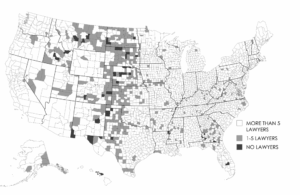Climate litigation comes to Wisconsin
Wisconsin’s climate is warming. Despite its characterization in some quarters as a “climate haven” and destination for people migrating away from the worst impacts of climate change, the state is not immune to some of those same consequences. Even setting aside the significantly warming temperature here, the effects already include more frequent, intense precipitation events, increased flood risk, and decreased opportunities for winter recreation. Wisconsinites living in the southeastern part of the state will long remember the August 9-10, 2025 rainfall event that hammered some areas with over 14 inches of rain in under 24 hours, leading to widespread flooding. No doubt that was a “1,000-year storm” by reference to past experience. But when it comes to climate, the past is no longer a good guide to the future; indeed, some parts of the state have recently experienced multiple “500-year storms” or “500-year floods” within only a few years of time.
Perhaps it is no coincidence, then, that as the state increasingly feels the effects of climate change, climate law cases are similarly piling up here. From constitutional claims that seek to reform the implementation of energy law in the state, to litigation over the federal government’s efforts to claw back funding for the development of renewable energy resources, Wisconsin has become increasingly involved with legal battles over the climate. Interestingly, one of the cases prominently invokes a constitutional doctrine connected to the state’s water resources.
Dunn v. Public Service Commission. In August 2025, fifteen Wisconsin youth filed suit in the Circuit Court for Dane County alleging that certain Wisconsin statutes “create and perpetuate a fossil fuel-dominated electricity sector,” resulting in climate change-driven injuries to plaintiffs caused by air pollution, extreme weather events, and degradation of Wisconsin’s public trust (water) resources. Plaintiffs assert this amounts to a violation of the Wisconsin Constitution’s guarantees of life, liberty, and “a stable climate system.” That last phrase doesn’t appear in the constitution, but plaintiffs argue that it is inherent in the enumerated rights of life, liberty, and the pursuit of happiness. The case is a cousin of similar youth-led suits filed across the country, including a recent notable success in the Supreme Court of Montana.
The claims involve the work of the Wisconsin Public Service Commission (PSC), which is charged with approving the construction of new facilities that will generate electricity in the state. The Dunn plaintiffs allege that one Wisconsin statute unlawfully prohibits the PSC from considering the air pollution these proposed facilities will emit, leading to an artificial bias in favor of electricity generation from fossil fuels rather than renewable resources. A second set of challenged laws, plaintiffs allege, creates an artificial and unlawful ceiling on the amount of renewable energy generation the PSC may require energy providers to supply.
Alternatively – and particularly thought-provoking for those interested in Wisconsin water law – the plaintiffs allege that the same statutes also violate the Wisconsin public trust doctrine by depriving the plaintiffs of “the [constitutionally guaranteed] right to access, enjoy, and use public trust waters.” Over the years I have written several times in this space about the Wisconsin public trust doctrine, including its recent re-solidification after a period of erosion. In short, Wisconsin courts have interpreted Article IX, Section 1 of the state’s constitution to mean that Wisconsin holds its navigable waters in trust for its people, but the courts have had some difficulty operationalizing exactly what that duty requires in terms of day-to-day management of Wisconsin waters. The plaintiffs in Dunn argue that climate-driven damage to Wisconsin water resources enabled by the PSC’s (statutorily mandated) decisions related to electricity generation equates to a breach of the state’s constitutional public trust obligations. If a Wisconsin court accepts that framing, Dunn could become a nationally significant point of climate law evolution.
While Dunn targets the legal architecture of the state’s energy system, another pending case is focused on funding for the development of renewable energy generation in Wisconsin.
Maryland Clean Energy Center, et al. v. United States. Wisconsin (through the Wisconsin Economic Development Corporation, a public-private entity created in 2011 to replace the former Department of Commerce) has joined other states and organizations suing over EPA’s decision to terminate the “Solar for All” program, which is aimed at improving access to solar energy infrastructure in lower-income and disadvantaged communities. The program was slated to fund about $7 billion in solar projects; Wisconsin would have received over $60 million of that amount. The controversy involves the recent reconciliation law passed in July, which Wisconsin and the other plaintiffs argue only rescinds unobligated balances of the funding, and is not a retroactive repeal of funding already issued under the program. In a related case, EPA has called such claims “hopeless,” arguing that Congress provided reasonable grounds for getting rid of the entire program and its associated funding.
Enbridge Line 5. The Wisconsin-based dispute over the rerouting of Enbridge Line 5, an oil and gas pipeline that crosses northern Wisconsin on its way from Canada to Michigan, is another fossil fuel-related case with national relevance. Litigation over the pipeline, and the fossil fuel resources it transports, is ongoing in several different jurisdictions. In our state, the Bad River Band of Lake Superior Chippewa has challenged the Wisconsin Department of Natural Resources’ issuance of permits approving a 41-mile new section of the pipeline, arguing that the DNR’s approval fails to comply with Wisconsin’s environmental laws and will damage wetlands and water resources, thereby threatening the Band’s way of life. The case is currently pending before a Wisconsin administrative law judge.
Though Wisconsin isn’t the first state that comes to mind in a conversation about climate risk, the outcome of these cases will be very significant to the development of climate law both within and outside the state.

